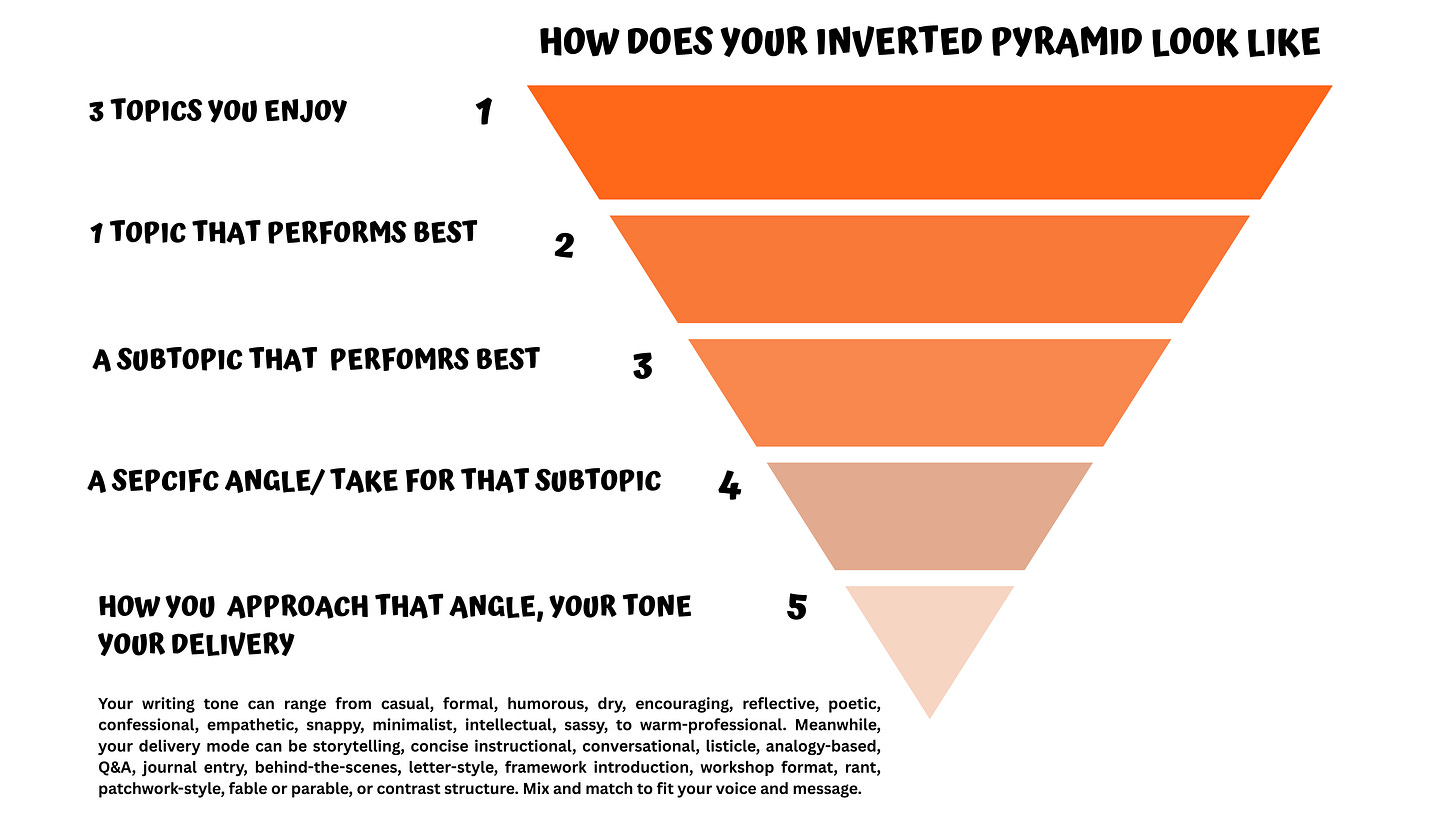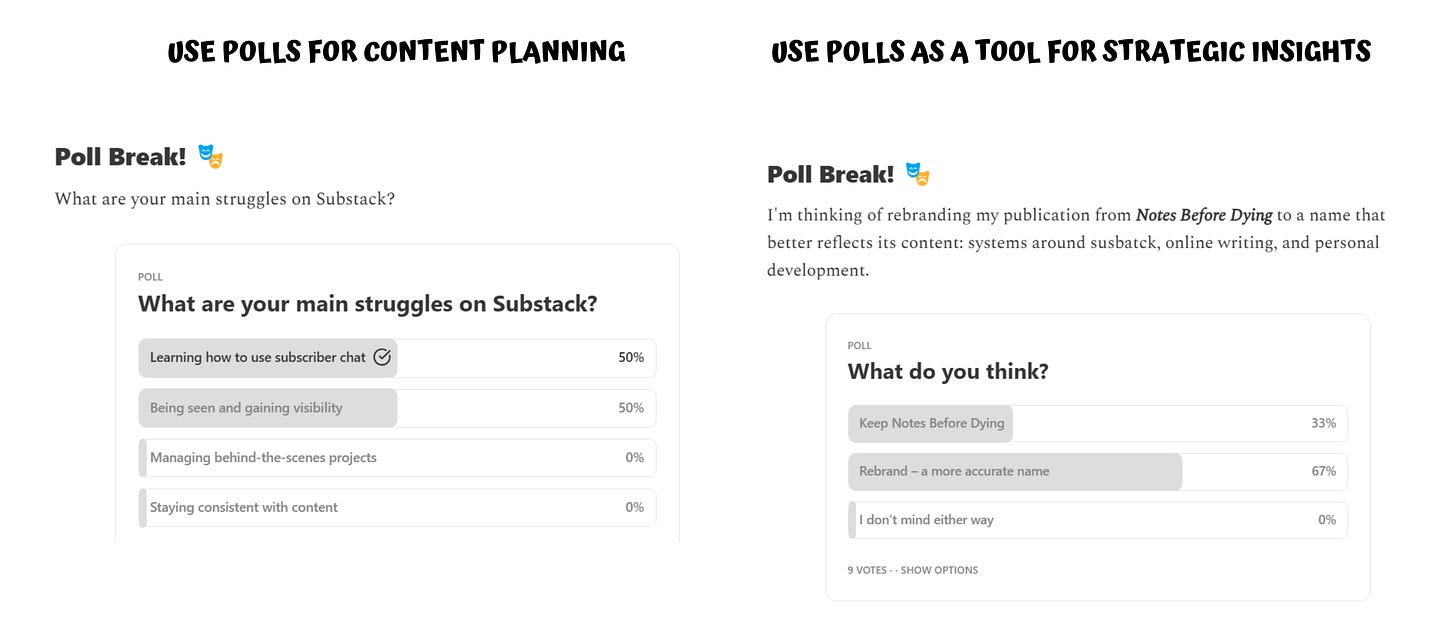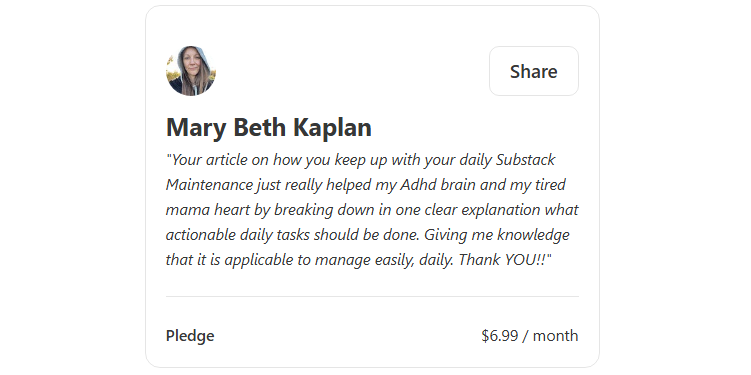4 Tools for Beginners to Find Their Niche
Finding Your Niche and Doubling Down Masterclass – Part 2
🔁 Quick Recap of on Part 1
In case you missed it, here’s a quick look back at what we covered on Part 1:
Why having a niche matters
The cost of not having one
And how the best place to start looking is with… you
If you haven’t read Part 1 yet and those topics sound interesting, you can check it out here.
Finding Your Niche and Doubling Down Masterclass – Part 1
Welcome to the “Finding Your Niche: Doubling Down Masterclass”!
What You’ll Get From Part 2
So in Part 1, I laid out the why behind niching down.
But here in Part 2, we’re diving into the how—starting with your own knowledge base and then testing what resonates with your audience.
Here’s the short version of the formula:
What you enjoy writing + What your readers want from you = Your niche
Now here’s the thing:
Figuring out what you like writing about? That’s the easy part.
Figuring out what your audience likes reading from you? That’s the hard part.
My idea of figuring out what works used to be just churning out endless articles. I was relying on pure hard work alone. In this post, I’ll share the tools I wish I had started using earlier—ones that would’ve saved me so much time and effort.
The Hard Part: Knowing What Readers Want
I like to think of this stage as a cycle.
You:
Write about the topics you enjoy
Collect data from your posts and other signals
Use those insights to refine your niche
Then repeat. Again and again.
Because finding your niche isn’t just about discovery—it’s also about creation.
You’re not just choosing a niche. You’re shaping it into something that’s unmistakably yours. A specific topic, taken from a specific angle, a voice, a structure —something that can’t be replicated because no one else does it like you.
My Niche Discovery in Action
I made a model to better visualize what my niche currently looks like. I like to think of it as an inverted pyramid—starting broad and narrowing down to more specific elements. Each level is defined by a particular aspect, as you can see in the figure.
You can use the pyramid as well as a guide to clarify your own niche.
And personally, this is how my inverted pyramid looks.
Here is the process I went through to come up with it.
The next part shows the tools I used along the way.
When I started, I had three main topics I wanted to write about:
🧫 Microbiology
📚 Online Writing
⚙️ Productivity
All three were areas I was familiar with and I was pasisonate aboue. I started writing about all of them to test the waters.
But I noticed something:
🧫 My science articles didn’t perform well, so I gradually wrote fewer of them.
📚 My online writing pieces? They did great.
⚙️ Productivity was doing okay too—but not as consistent.
So I focused on the two that were performing better (Online writing & Productivity )
Over time, even within those two, I saw something more specific:
The posts that did especially well were the ones where I shared my systems—how I manage my Substack, organize my processes, and build writing habits.
That’s when I knew I hit something.
So I doubled down:
I wrote more about Substack systems.
I refined how I presented them (adding graphs, illustrations, templates).
And I paired it with my usual conversational tone with a hint of instruction.
💡 That became my niche:
Systems for beginner Substack writers, presented in a simple, friendly way and instructional way targetted towards beginners.
But I want to clarify:
This doesn’t mean I only write about this.
I still write about productivity —especially habit-building and consistency.
In fact this is what I call my secondary niche.
My inverted pyramid for this (my seconday niche: Productivity) topic looks like this:
But I’m more intentional about which ones I pursue.
Think Pareto: Find the 20% That Drives 80%
If you’re familiar with the Pareto Principle, this is a great place to apply it.
80% of your results often come from 20% of your content.
I now focus on the 20% (a.k.a. my primary niche) that brings growth, engagement, and satisfaction—and let the rest play a supporting role.
This applies to all subtopics too, and it’s generally how I design my content strategy. The things you see written in each of the pyramid level, is my 20% in each level.
This Is an Experimental Process
And yes—it takes time and effort. When I started, I had no idea what I was doing. I didn’t even realize all of this at the time.
I just had a goal: to figure out my niche.
But I didn’t have any strategy, system, or structure to get there. Admittedly, I probably lost a lot of time because of it, just going back and forth with no clear direction.
Eventually, I pieced together everything I learned, unlearned, and experienced.
Which brings me to the tools I wish I had used from the beginning—ones that would’ve saved me so much time and energy. Not just on finding out my niche but also on other things regarding the management of the newsletter.
Tools I Use to Niche Down
1. Polls
Use polls inside your Substack posts.
This is usually most helpful for short-term planning—like what topic you’d work on next, what article they want to read next, or even real-time decision making, for me I asked my audience on the topic of rebranding.
You can see some examples of these polls bellow:
Or, if you’re a bit further down the pyramid and you’ve already determined your niche, you can use polls to narrow it down even more by asking the audience what subtopic they want to learn about. Like what I did in the 1st picture on the figure.
As you may have noticed, my polls are already quite specific because I just recently implemented them—now that I already have a confirmed niche but I wish I started using them earlier.
2. Subscriber Surveys
This is one of the powers of a welcome email that often gets overlooked. If you’re are a recent subscriber ou’ve probably seen a short section inviting newcomers to answer a one-question survey.
I wish I set this up earlier as well.imagine how much more direction I could’ve had from day one.
Here’s what my new subscriber survey looks like. I used Google Forms for mine, and you can add anything you want to know from your readers.
Downside: Both polls and surveys rely on your audience’s willingness to respond.
Even with hundreds of subscribers, I’ve had polls with only 7 responses. It’s limited. The main disadvantage is that it depends on the subscribers—it’s not always representative of your entire audience.
It gives you some sort of direction, but it could be heavily skewed.
Which is why, admittedly, I put more weight on tools that analyze unbiased data.
This brings me to the third tool.
3. Performance Tracker (via Notion)
This is my favorite one and the first one I used.
Because it shows what’s actually happening.
It takes more effort in the beginning compared to the other tools, but once you’ve set it up, it only needs to be updated every now and then—and the insights are much more reliable and comprehensive.
I can also use it for multiple purposes, and it removes a lot of the biases that come from relying purely on feedback-based tools like polls and surveys.
Here’s a quick overview of how the Notion system I built functions:
(We’ll dive deeper in Part Three-how I set it up, how I use it, and what I actually get from it.)
I have a database that lists the three big niche categories I’m exploring.
It shows me which niche performs best based on the number of subscribers and views per article.
This niche database automatically pulls in data from all my published posts (coming from a separate article performance tracker—which we’ll also get into in Part Three).
This tracker gives me three key insights:
What I naturally gravitate toward – based on the number of articles I’ve written under each niche, and whether that’s proportional to…
What performs best – measured by views and subscribers per articles published. From there, I can adjust my focus accordingly based on…
What feels low-effort, high-reward – so I can double down on what’s working without burning out.
I also use this to niche down even further.
Remember the tags feature?
In Subsbatck we assign specific tags to each article (i my publication my tags represent subtopics under my broader niche), and I analyze which tag clusters perform better compared to others.
And lastly, what I think is the most important (and most overlooked) indicator by writers… is the next one.👇
What Most Writers Miss: Thoughtful Engagement
Early on, I judged success by views, likes, and subscriber count.
But over time, I’ve learned to pay more attention to thoughtful feedback.
If someone:
Leaves a comment
Messages you to say something helped
Or even tips you for a specific post
…that tells you way more than stats ever could.
One of my most appreciated pieces was the Substack maintenance system I shared—people messaged me, donated, and told me it helped them immediately and how it helped them.
That kind of response showed me exactly where I’m most useful.
Why?
Because this kind of feedback shows me the specific aspects of the articles—under a strong niche—that make them truly appealing to the audience.
Why are they effective?
Why are they performing well?
It's not just because of the topic itself. But how you deliver and present the topic, things you can find lower in the pyramid earlier.
They help me zoom in:
Is it the way I deliver things through relatable stories?
Was it because I kept the article short and easy to read?
In my case, it turns out—no.
It’s the process itself.
It’s how I explain things and share systems I’ve personally built and used. That’s where the real strength lies. That’s what makes these articles stand out.
It’s the organization—clearing the clutter, engineering the sequence.
The way the content is broken down, made actionable, and grounded in real experience—that’s what clicks with people.
This is for me—and I can honestly say, it became the strength of my article because it’s been a strength of mine for a long time… without me even realizing it. If I didn’t share it here, I wouldn’t have seen it so clearly either (the joy of writing also comes from the many things you discorver about yourself).
Even before Substack, I was already geeking out on building systems—for myself, for my studies, for everything.
In university, I had full systems for:
managing my reading lists
planning how I’d study for each subject
organizing goals and to-dos
and even my personal bucket list (yes, that too—it’s all in Notion)
After graduating, I created an entire system to review for the microbiology certification exam, which helped me almost land in the top 10 in the whole country. (Here’s the article where I talk more about that.)
So when readers tell me these systems help them too, it clicks.
It’s not just a nice comment—it’s a reflection of where my real value lies.
Stats can show you reach. But comments?
They show resonance.
So yes, still track your numbers. But really listen to your readers.
Their interactions often mean more than you think.
Final Thoughts:
Finding your niche isn’t a one-and-done task.
It’s continuous refinement—a mix of data and intuition.And it doesn’t just help you write better.
It helps your audience find you faster.
Up Next:
I'll be doing a deep dive into my Notion setup and how I use it to guide my writing. I’ll also be covering how I make tags more useful in narrowing down and organizing my content. This system has helped me stay on track with my niche and focus on the topics that truly resonate with my audience.
That’s all for today!. I appreciate you so much for reading up until here! 😊 If you think this article could help someone, feel free to share it or like it—it really helps expand its reach to help others as well. 💌
Frey.
All my content is currently free, but if you’d like to support my work, you can buy me a coffee on Ko-Fi! ☕✨ Every bit helps me keep creating contents like these. Thank you! 💛
Want to go deeper?
Subscribe for free to join my subscriber-only chat, where I share behind-the-scenes insights, early drafts, and content-building prompts to help you grow.
You'll also get access to my personal notes, systems, and strategies as I write and refine each piece.
Let’s build better content—together. 🚀














Nicely done. I learned a lot.